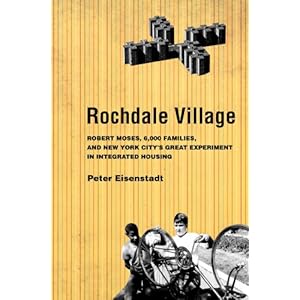Rochdale Village: Blueprint for a New Housing Option?

Few areas of New York City have had as many housing foreclosures in recent years as the neighborhoods in southeastern Queens, such as Jamaica, South Jamaica, St. Albans, and Laurelton—all with large tracts of modest private homes and a predominantly minority population. But one large area of southern Queens, Rochdale Village, has not had a single defaulted mortgage. All of its residents own their homes, and like the surrounding neighborhoods it has an overwhelmingly minority population, modestly middle class in its income and aspirations. What makes Rochdale different is that it is a limited equity cooperative, whose residents chose their management and govern themselves collectively. The 6,000 apartments, in twenty large apartment buildings, cannot be individually resold. If its residents cannot profit from real estate investments, they also cannot lose their homes and much of their savings when the market turns on them.
Rochdale Village, standing on the site of the former Jamaica Racetrack, opened in 1963. It was built by the United Housing Foundation (UHF), and followed the vision of its longtime leader, Abraham Kazan, who believed in creating attractive, affordable housing, for families of moderate income, all owned by their residents. Kazan was a product of the anarchist wing of the Jewish labor movement in the early twentieth century, and had been building cooperative housing for workers since the 1920s. Under the auspices of the UHF, largely a consortium of labor unions, he built over 30,000 units of cooperative housing in New York City from the early 1950s to the early 1970s, which made him the most successful developer of cooperative housing in the country.
Before Rochdale, most of Kazan’s cooperatives had tended to draw heavily from the Jewish labor movement, and Jewish families in general. Rochdale Village was different, and from the beginning had a substantial black population (and unlike previous UHF cooperatives, was in a predominantly African American neighborhood.) Rochdale Village touted its achievements as an integrated cooperative, and through the 1960s it was the largest integrated housing development in New York City, if not the United States as a whole.
Alas, this did not last, and the whites started to move out in the early 1970s, and in time Rochdale would become almost entirely African American, and today it remains the largest predominantly minority-owned cooperative in the country, a tribute to the determination of its residents to defend what is unique about Rochdale, and the flexibility and relevance of Kazan’s original cooperative vision.
The UHF built only one more cooperative after Rochdale, the gargantuan 15,000 unit Co-Op City in the Bronx, but after completing it in the early 1970s, it laid down its shovel and never built another unit of housing. The reasons for this are complex. One factor was the conviction of Jane Jacobs and her legion of followers that large scale superblock housing projects were sterile and dehumanizing, incubators of urban anomie, a reality belied by the generations of families of modest means who had cherished their homes in UHF-built cooperatives.
But the real question came down to money. By the early 1970s many had concluded that cooperatives such as Rochdale Village and Co-op City, privately owned but government sponsored, were costing the taxpayers too much money, and that in a time of inflation, revenues were not keeping up with expenses. The fiscal crisis of the mid-1970s seemed to confirm the prevailing wisdom; the government should, as much as possible get out of the housing biz. And so New York City was launched on the vertiginous explosion of housing prices that has largely priced the working, middle, and moderate classes out of New York City. If there was grumbling, most bought into, in more ways than one, the underlying rationale; that as long you own your place, and the prices appreciate, you could more than recoup your investment by selling to the next purchaser. But a system based on beggaring one’s neighbor could not last forever, and of course it came crashing down in 2007 and 2008, toxic asset by asset.
The Obama administration is currently wrestling with the problem of housing prices that continue to fall. Whatever is done, and this is a very serious problem, we need to reconsider the alternatives to the speculative housing market such as limited equity cooperatives, which for many decades have afforded families of modest incomes a way to own their homes without personal mortgages and high levels of individual indebtedness. Building affordable, attractive housing is not cheap, but neither is the $14 trillion or so in net worth the United States has lost since 2007 as a result of the burst housing bubble. Residents of Rochdale Village and Co-op City have both considered the path of privatization, and both have rejected it, and they remain places where three bedroom apartments are available for well under $1,000 in rent a month. A stay on the waiting list for a vacancy can stretch into the decades. Limited equity cooperatives have prospered, quietly, in the decades when the American dream seemed to be reduced to everyone becoming a real estate speculator. As we move forward, let us make room in our housing mix for new Rochdales and Co-op Cities, appropriately refashioned for the twenty-first century. Sometimes, Santayana to the contrary, only those who have learned something from history can know enough to repeat it.